
BEHIND THE SCENES OF OUR CSA PROGRAM
06/05/20 — Ada Broussard
This week we wanted to give you a behind the scenes look into our CSA program, its origins, and answer some of your questions. Did you know that our CSA program is one of the largest, true-CSA models, in the entire Southern United States? To our veteran and new members alike, thank you for buying our vegetables and helping to fuel this important and equitable model of food production.
CSA stands for Community Supported Agriculture, and it’s a system of growing produce true to its name. Your upfront, financial support, is what enables our farm to exist (!) in the agricultural sector. Before there is ever a tomato to pick, farmers have a tremendous amount of expenses to get the crop ready: they must buy the seed, pay for labor to grow the seed, fix the tractors, prep the soil, amend the soil with compost, buy the tomato cages, install the tomato cages, and so on and so on. Every crop is the same: upfront costs before we have something to sell. Traditional CSA models collect money for an entire season’s worth of vegetables. We offer a bit of flexibility with our subscription lengths, allowing you to sign up for just 4 weeks (or 52 if you’re a super-fan), but the money is still used in the same manner: helping us to prepare for the crops to come. Our farm, quite seriously, is supported by our local community, which thankfully, has a voracious appetite for fresh and organic produce. Why do we always do such a large CSA campaign every New Year? Vegetable-wise, it’s a risky time to invite brand new folks into the CSA: we’re dancing with dangers of killing frosts and a potential lapse in crop availability. But, it’s also one of the most expensive times for us at the farm as we prepare for the upcoming spring season.
![]() CSA flyer from many years ago drawn and designed by Ryan Rhodes. We sow, you reap. Still holds true!
CSA flyer from many years ago drawn and designed by Ryan Rhodes. We sow, you reap. Still holds true!
You, our community partner in this endeavor, also benefit from this system: by committing to a box of vegetables on a 4, 10, 26, or 52 week schedule, we are able to plan ahead and allocate portions of our harvest, specifically for you. To the occasional frustration of our Farmers’ Market, Restaurant, and Wholesale Managers, our CSA department gets dibs on any new crop, or on the highest quality version of any crop coming out of the fields.
As a business, we have always loved our CSA (maybe the most.. but you’re not supposed to have a favorite child, so don’t tell….). It’s the most direct way we can get our vegetables onto plates. Our CSA Program began with 30 families buying produce directly from Brenton’s backyard on Holly Street (in East Austin). Feeding people is why we farm, so this direct partnership with our community checks all the boxes. Unlike many vegetable delivery or meal kit programs, food is coming directly from the JBG fields to your kitchen, not spending any time in a storage facility or in unnecessary transit. Vegetables delivered through a CSA model arrive at your doorstep closer to their harvest date: they’re fresher, taste better, are more nutritious, and are better for the environment (fewer food miles).
![]() Photo from the archive: CSA Members picking up their shares from the Sunset Valley Farmers' market. Photo by Scott David Gordon.
Photo from the archive: CSA Members picking up their shares from the Sunset Valley Farmers' market. Photo by Scott David Gordon.
With the onset of Covid-19, local demand for our safe and nutritious produce has increased… dramatically. The size of our CSA has nearly tripled since the end of February, and we are so proud and motivated to provide our vegetables to any and all who are interested in making this commitment to a local, more sustainable and more equitable food system. Goodness knows our world needs more equitable systems, and sourcing your food from a farm that takes the welfare of its 100+ employees (as well as the welfare of the land it stewards) very seriously is just one small way to influence a complex, and often unjust food system. In order to meet this humbling demand, we have made a few temporary changes to our CSA program and thought we’d share some FAQs about these changes, and the program, in general.
![]() CSA boxes get packed according to their delivery route. Once we're done packing one driver's boxes, the pallet gets wrapped so it can be easily loaded into a van with a fork lift. Boxes are packed with the first deliveries on top, so all the driver must do is unwrap the pallet... like a burrito! Photo by Scott David Gordon.
CSA boxes get packed according to their delivery route. Once we're done packing one driver's boxes, the pallet gets wrapped so it can be easily loaded into a van with a fork lift. Boxes are packed with the first deliveries on top, so all the driver must do is unwrap the pallet... like a burrito! Photo by Scott David Gordon.
Can I choose what's in my box each week? At this moment, you are not able to choose the vegetables that are in your CSA share. We’ve taken the guesswork out for you! We build the boxes based on what’s freshest and most bountiful in the fields. Our CSA members most often get the newest crops before they’re sent to market or delivered to restaurants. We put a lot of care and attention into each week’s box contents, making sure to offer each box size week-to-week variety, and balance the leafy greens with the starchy roots. If you’ve been a member for a while, you may be wondering about our customization feature. This feature has been temporarily paused while the farm sifts through these unchartered waters. We’ve been fortunate to be able to offer this feature for many years, and we promise we’re trying to figure out a way to bring it back in the future. Thanks for sticking with us.
How do I know what is coming in my box? Beginning on Saturday of every week, you can login to your CSA account and see the box contents for the following week. To do this, click on your upcoming delivery and then the button that says “View Box Contents”. Because we sometimes have to slightly adjust the box contents to account for quality, shortages, or any of the other numbers factors that can affect a farm’s harvest, you have a designated window when you can logon to see next week’s contents. Below is a chart detailing when you can login to your account and see what’s coming up.
![]()
![]() Some folks like to know what's coming in the CSA shares, and some like the element of surprise. How do you CSA? Photo by Scott David Gordon.
Some folks like to know what's coming in the CSA shares, and some like the element of surprise. How do you CSA? Photo by Scott David Gordon.
What if I am allergic to certain vegetables? We are happy to accommodate boxes for food allergies. If you need to avoid certain vegetables due to allergies, please email Faith: farm@jbgorganic.com .
How do you decide what’s going to be in the boxes? This is a decision-making matrix that is as complex as the days are long! Very generally, we decide the types of crops we would like to see in CSA boxes based on what can grow in Texas, during what season (duh), with a few “maybes” thrown in there for fun. We think about the amount of row feet we have available to plant, the average yields per foot of different crops, and the amount of acreage we need to set aside for cover cropping. We try to think, realistically, about the amount of labor that 1)is available (farm work is hard!) and 2)affordable, and then plant accordingly. Sure, we have the capacity to grow and plant 55,000 tomato plants… but do we have the labor to pick all these tomatoes when they all start to fruit in a short 5-week span? This type of big-picture crop planning happens months in advance (most of August is usually spent crop planning for the Spring season, for example). Like any good farmer, we also use our experience (and longitudinal data) to inform these decisions. Which crops did customers most often complain about? What didn’t sell well at markets? Let’s plant less of that next year. Which varieties of peppers stored well and were easiest to harvest? More of those.
Once the crops are in the ground, we make decisions on what is going into our CSA boxes based on more immediate factors, like, what soon-to-be ripe fruit is actually in the fields and, what do we think you’ll like? Tracy, our barn manager, spends at least one day a week in the fields, simply scouting and making notes about the ready-to-roll crops in the fields. Sure, we have a lot of information about what is planted, where, in spreadsheets, but it really takes driving around, getting out of the truck, and walking through rows of eggplant to know if they’re box-worthy. Not all of a certain vegetable will be ready at the same time, and this is something we’re also having to plan for.
![]() Tracy caught doing some field scouting, looking particularly cool if we do say so.. Photo by Scott David Gordon.
Tracy caught doing some field scouting, looking particularly cool if we do say so.. Photo by Scott David Gordon.
Over the years, we’ve gotten better at succession planting, or the process of spacing out the timing of your plantings so as to extend the crop availability. This year’s green bean crop was a good example. We harvest green beans mechanically, but they are a very labor-intensive crop post-harvest; we have to sort out lots of stems and leaves, and also weigh out and bag the beans. Because we planted the green beans on a more strategic (spaced out) schedule, they were not all ready at once. This means that the quantity of beans harvested was more manageable, and asking our crews to bag the beans was a big (added) task, but not an insurmountable one. Hence, we were able to include more green beans than ever in your CSA shares! Beans tell this tale, too: different crops take different amount of time to harvest and process, so so each week when planning the contents, we also take into consideration the amount of labor we have, how many units of a particular vegetable we need, and try to make sure that we’re not stacking too many labor-intensive vegetables at the same time.
![]() After harvest, green beans get sent through this sorter which we endearingly refer to as the "Mean Green Bean Sorting Machine." Photo of Taylor and Tracy from the archives by Scott David Gordon.
After harvest, green beans get sent through this sorter which we endearingly refer to as the "Mean Green Bean Sorting Machine." Photo of Taylor and Tracy from the archives by Scott David Gordon.
Our number one goal in choosing the box contents is to create a CSA box that you’ll enjoy. Each week, we try to ensure that boxes consist of at least 50-60% of vegetables that we consider staples - carrots, dark leafy greens, potatoes (coming soon: tomatoes!)… as well as some crops that might be new to you, are considered specialty, or are limited in quantity because they’re the very first of the season. Many of our customers receiving Medium and Large boxes are on every-other week schedules, and so when we decide to include a particularly exciting vegetable (that is maybe limited in availability) we make sure that we can do this for two weeks in a row so every customer gets to experience the excitement, at least once. But of course box contents can’t be too similar from week to week, because many of you get a box every week! This brings up an important point, however: when you choose to eat seasonally and locally, the number of crops that are able to be grown in your region at any particular time are going to be less than the variety that you may be accustomed to seeing in the grocery store; so much of this produce is shipped in from different parts of the world, experiencing different growing seasons!. If you’re new to the CSA, you may find yourself opening your box from time to time sighing “Squash, again?”. But stick with the CSA long enough, and not only will you learn 50 wildly different ways to eat squash, but you’ll also recognize the temporal nature of it all. Enjoy the squash bounty (heck, maybe pickle some!) while it lasts, because soon it will be December and you’ll forget what the tender yellow gourds even look like.
Why do the box contents sometimes differ from the contents I was expecting? Whewf! This is a big question. Why did a troop of grasshoppers descend overnight to block A4 of kale? Why did the week of sunshine that we were expecting to size up our squash suddenly shift to a week of clouds? We sometimes have to substitute items in your box due to a catalog of unforeseeable variables which affect either 1)the anticipated quantity of a certain crop or 2)the anticipated quality of a certain crop. Perhaps we had planned to include tender and delicate chard in the boxes because the daily temperatures were looking to be moderate. If the temps spike, we may make a last minute decision to switch this green to kale which can stand up to higher post-harvest temps. We finalize every week’s box contents on the Friday of the week prior, and make sure to enter the quantities we need harvested into our spreadsheet so that this information is waiting for our harvest manager when he gets to work at 5am on Monday. Perhaps a weekend of heavy rain damaged crops on Sunday that looked perfect on Friday. Sometimes, substitutions happen because of mechanical woes: the potato harvester suddenly lost a bolt, and the replacement for said-bolt only exists at one scrap yard (that happens to have the same year and make of our potato harvester) on the West Coast. Even two-day air shipping means that Tuesday boxes may miss out on planned potatoes. Weather, pests, labor, equipment…there are many moments, every day, when we’re called to shift and adapt our plans. That’s farming. More often than not, we’re able to adapt and still make the potatoes happen. But sometimes, we’ve got to send carrots, instead.
When we have no choice but to make a substitution, we always try to sub a like for a like. A bunched green for a bunched green, an herb for an herb, a carrot for a potato (they’re both starchy, root crops, and can be used very similarly!). We hope you learn to roll with the punches when there is dill instead of the expected parsley. Part of being a CSA Member is getting to know your seasons, and there is no more authentic way to know your seasons than to know and understand the variability that even a day can hold. We know you like to plan your meals ahead of time (meal planning is the best!) and we invite you to employ the same flexibility that we practice as farmers as cooks in the kitchen. It’s part of the fun of being a CSA Member, we think! Cooking, like farming, isn’t rigid and subbing parsley for dill will likely taste just fine!
Why does the value of my box sometimes seem to be less than what I’m paying for? Why can I find organic produce that is sometimes cheaper in the grocery store? The CSA boxes are valued at the overall average value, so the exact value may vary box-to-box. There are times in the year (ex: summer) when we have abundant, varied crops, and can give our members more than the box's dollar amount. We also include items like cabbage and cauliflower by count rather than weight, which gives you a better deal. Occasionally, there will be a week when your box may contain one less item than your used to, but we promise that the bonus veggies that come your way throughout a season more than make up for this deficit. For this reason, our CSA program truly is the most economical way to purchase our produce. The cost of food production is often undervalued and also hidden. Occasionally, you may be able to find cheaper versions of organic produce at the grocery store which is produced by highly mechanized farms. Here, the hidden costs lie in the poor working conditions of employees and poor management of farmland and soil health.
Who is the CSA Crew? Really, it’s a whole-farm effort to grow the vegetables for your CSA box. Krishna, Brenton, Andrew, Tracy and Jack all spend weeks crop planning for upcoming seasons. Our greenhouse manager Giana cares for the plant babies that will eventually produce your vegetables. A harvest team of 15-20 folks harvest the vegetables, mostly by hand. There is the barn crew that all pitches in to wash and sort the vegetables, and then there is the CSA team that folds, labels, packs, and checks each and every CSA box. This crew consists of our fearless CSA Packing Manager, Andrew, plus Alexander, Nick, and Brisa. Faith orchestrates the deliveries (and answers your queries), Krishna is making sure we all get paid (among one billion other tasks), and our delivery drivers spend anywhere from 8-10 hours a day bringing you the produce.
![]() Formatting, organizing, and checking our CSA labels is one of the first things Faith does every morning. There's no worse feeling than when the CSA crew is waiting on their labels! Here is Faith handing the labels off to Alexander. Ready, set, pack! Photo by Scott David Gordon.
Formatting, organizing, and checking our CSA labels is one of the first things Faith does every morning. There's no worse feeling than when the CSA crew is waiting on their labels! Here is Faith handing the labels off to Alexander. Ready, set, pack! Photo by Scott David Gordon.
![]() Did we mention Krishna is our number-one multi tasker? Here's a photo from the archives where he's cooking lunch for the barn crew and coordinating van repairs... all at once. Photo by Scott David Gordon.
Did we mention Krishna is our number-one multi tasker? Here's a photo from the archives where he's cooking lunch for the barn crew and coordinating van repairs... all at once. Photo by Scott David Gordon.
What is the best way to store my veggies? Okay, this blog post is getting long! If you’re curious about veggie storage, checkout the blog post we devoted specifically to this topic.
What is the best way to eat my veggies? With your mouth! But really, we have a wonderful recipe archive on our website. The recipes listed here were written and developed by CSA Members like you and if you’re stumped, this is a great resource.
If you made it to the bottom of this post, thank you for reading. We hope this post helps you better understand some of the behind the scenes work that goes into making our CSA Program. If you have any questions, please don't hesitate to ask! Comment below or shoot us an email. As always, thank you for supporting local agriculture. We are so grateful for all of you who make up our vibrant and hungry community!
![]()
CSA stands for Community Supported Agriculture, and it’s a system of growing produce true to its name. Your upfront, financial support, is what enables our farm to exist (!) in the agricultural sector. Before there is ever a tomato to pick, farmers have a tremendous amount of expenses to get the crop ready: they must buy the seed, pay for labor to grow the seed, fix the tractors, prep the soil, amend the soil with compost, buy the tomato cages, install the tomato cages, and so on and so on. Every crop is the same: upfront costs before we have something to sell. Traditional CSA models collect money for an entire season’s worth of vegetables. We offer a bit of flexibility with our subscription lengths, allowing you to sign up for just 4 weeks (or 52 if you’re a super-fan), but the money is still used in the same manner: helping us to prepare for the crops to come. Our farm, quite seriously, is supported by our local community, which thankfully, has a voracious appetite for fresh and organic produce. Why do we always do such a large CSA campaign every New Year? Vegetable-wise, it’s a risky time to invite brand new folks into the CSA: we’re dancing with dangers of killing frosts and a potential lapse in crop availability. But, it’s also one of the most expensive times for us at the farm as we prepare for the upcoming spring season.
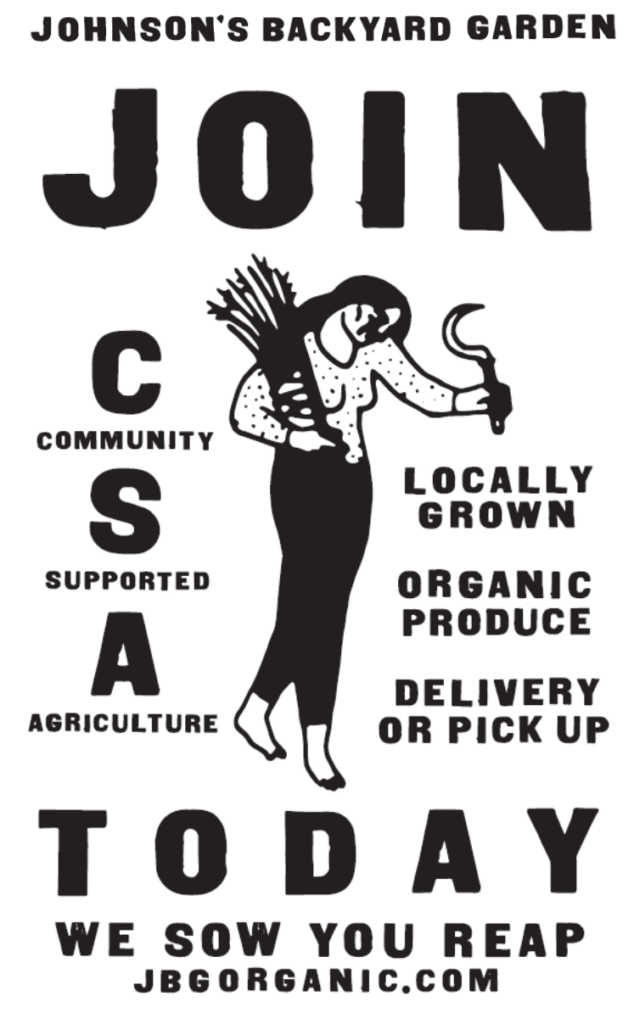 CSA flyer from many years ago drawn and designed by Ryan Rhodes. We sow, you reap. Still holds true!
CSA flyer from many years ago drawn and designed by Ryan Rhodes. We sow, you reap. Still holds true!
You, our community partner in this endeavor, also benefit from this system: by committing to a box of vegetables on a 4, 10, 26, or 52 week schedule, we are able to plan ahead and allocate portions of our harvest, specifically for you. To the occasional frustration of our Farmers’ Market, Restaurant, and Wholesale Managers, our CSA department gets dibs on any new crop, or on the highest quality version of any crop coming out of the fields.
As a business, we have always loved our CSA (maybe the most.. but you’re not supposed to have a favorite child, so don’t tell….). It’s the most direct way we can get our vegetables onto plates. Our CSA Program began with 30 families buying produce directly from Brenton’s backyard on Holly Street (in East Austin). Feeding people is why we farm, so this direct partnership with our community checks all the boxes. Unlike many vegetable delivery or meal kit programs, food is coming directly from the JBG fields to your kitchen, not spending any time in a storage facility or in unnecessary transit. Vegetables delivered through a CSA model arrive at your doorstep closer to their harvest date: they’re fresher, taste better, are more nutritious, and are better for the environment (fewer food miles).
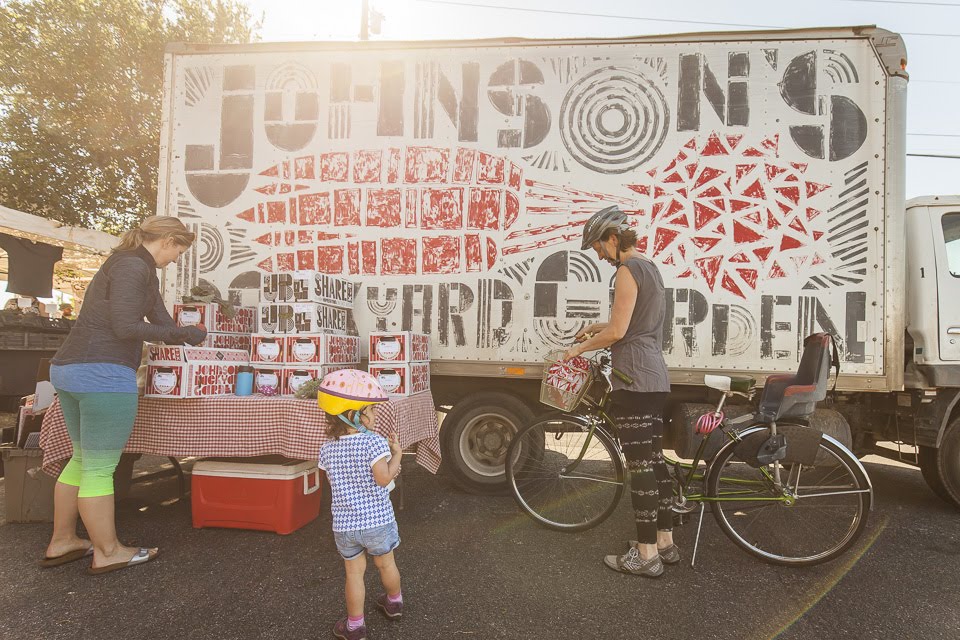 Photo from the archive: CSA Members picking up their shares from the Sunset Valley Farmers' market. Photo by Scott David Gordon.
Photo from the archive: CSA Members picking up their shares from the Sunset Valley Farmers' market. Photo by Scott David Gordon.
With the onset of Covid-19, local demand for our safe and nutritious produce has increased… dramatically. The size of our CSA has nearly tripled since the end of February, and we are so proud and motivated to provide our vegetables to any and all who are interested in making this commitment to a local, more sustainable and more equitable food system. Goodness knows our world needs more equitable systems, and sourcing your food from a farm that takes the welfare of its 100+ employees (as well as the welfare of the land it stewards) very seriously is just one small way to influence a complex, and often unjust food system. In order to meet this humbling demand, we have made a few temporary changes to our CSA program and thought we’d share some FAQs about these changes, and the program, in general.
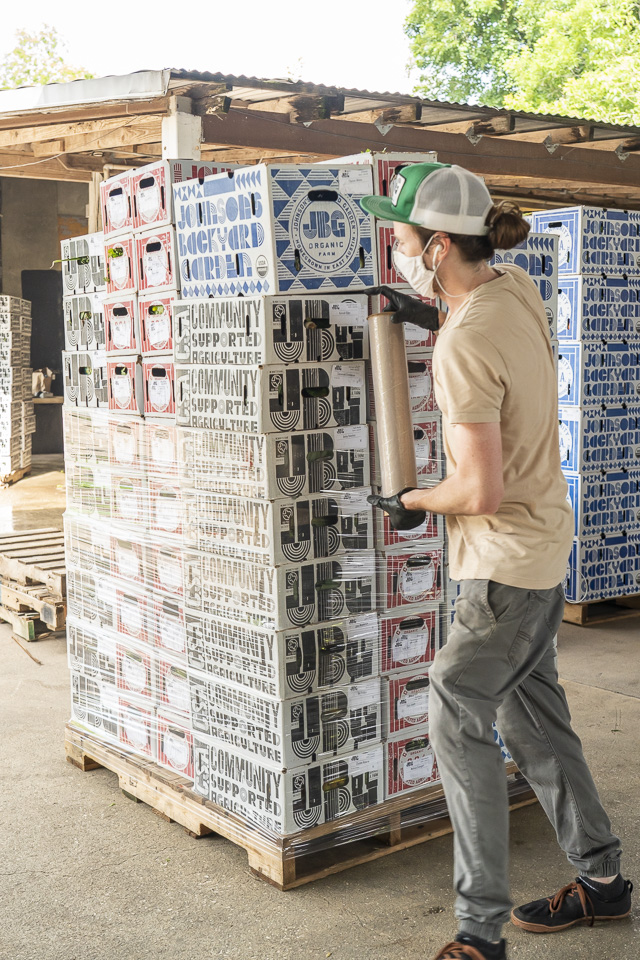 CSA boxes get packed according to their delivery route. Once we're done packing one driver's boxes, the pallet gets wrapped so it can be easily loaded into a van with a fork lift. Boxes are packed with the first deliveries on top, so all the driver must do is unwrap the pallet... like a burrito! Photo by Scott David Gordon.
CSA boxes get packed according to their delivery route. Once we're done packing one driver's boxes, the pallet gets wrapped so it can be easily loaded into a van with a fork lift. Boxes are packed with the first deliveries on top, so all the driver must do is unwrap the pallet... like a burrito! Photo by Scott David Gordon.
Can I choose what's in my box each week? At this moment, you are not able to choose the vegetables that are in your CSA share. We’ve taken the guesswork out for you! We build the boxes based on what’s freshest and most bountiful in the fields. Our CSA members most often get the newest crops before they’re sent to market or delivered to restaurants. We put a lot of care and attention into each week’s box contents, making sure to offer each box size week-to-week variety, and balance the leafy greens with the starchy roots. If you’ve been a member for a while, you may be wondering about our customization feature. This feature has been temporarily paused while the farm sifts through these unchartered waters. We’ve been fortunate to be able to offer this feature for many years, and we promise we’re trying to figure out a way to bring it back in the future. Thanks for sticking with us.
How do I know what is coming in my box? Beginning on Saturday of every week, you can login to your CSA account and see the box contents for the following week. To do this, click on your upcoming delivery and then the button that says “View Box Contents”. Because we sometimes have to slightly adjust the box contents to account for quality, shortages, or any of the other numbers factors that can affect a farm’s harvest, you have a designated window when you can logon to see next week’s contents. Below is a chart detailing when you can login to your account and see what’s coming up.
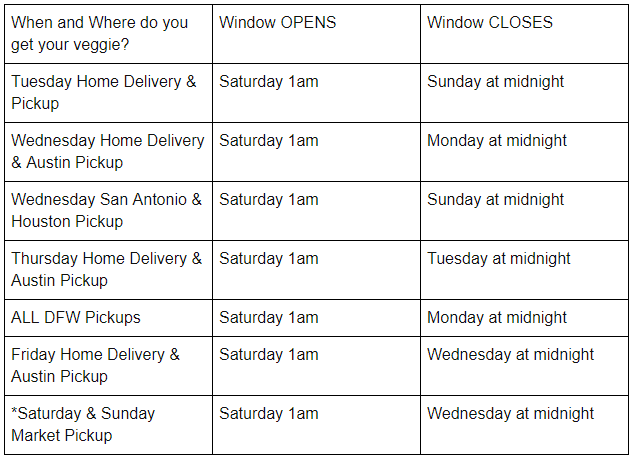
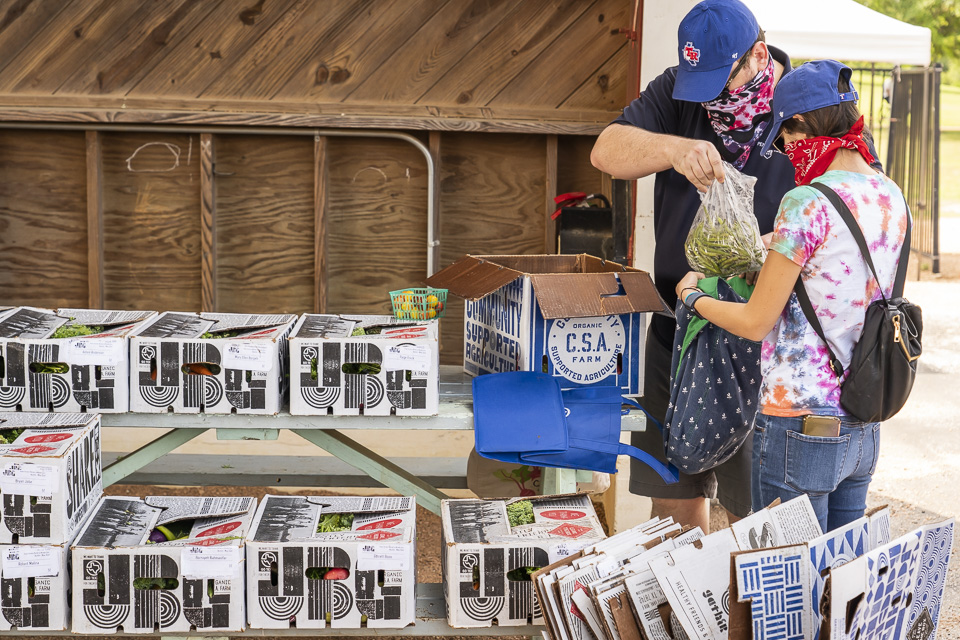 Some folks like to know what's coming in the CSA shares, and some like the element of surprise. How do you CSA? Photo by Scott David Gordon.
Some folks like to know what's coming in the CSA shares, and some like the element of surprise. How do you CSA? Photo by Scott David Gordon.
What if I am allergic to certain vegetables? We are happy to accommodate boxes for food allergies. If you need to avoid certain vegetables due to allergies, please email Faith: farm@jbgorganic.com .
How do you decide what’s going to be in the boxes? This is a decision-making matrix that is as complex as the days are long! Very generally, we decide the types of crops we would like to see in CSA boxes based on what can grow in Texas, during what season (duh), with a few “maybes” thrown in there for fun. We think about the amount of row feet we have available to plant, the average yields per foot of different crops, and the amount of acreage we need to set aside for cover cropping. We try to think, realistically, about the amount of labor that 1)is available (farm work is hard!) and 2)affordable, and then plant accordingly. Sure, we have the capacity to grow and plant 55,000 tomato plants… but do we have the labor to pick all these tomatoes when they all start to fruit in a short 5-week span? This type of big-picture crop planning happens months in advance (most of August is usually spent crop planning for the Spring season, for example). Like any good farmer, we also use our experience (and longitudinal data) to inform these decisions. Which crops did customers most often complain about? What didn’t sell well at markets? Let’s plant less of that next year. Which varieties of peppers stored well and were easiest to harvest? More of those.
Once the crops are in the ground, we make decisions on what is going into our CSA boxes based on more immediate factors, like, what soon-to-be ripe fruit is actually in the fields and, what do we think you’ll like? Tracy, our barn manager, spends at least one day a week in the fields, simply scouting and making notes about the ready-to-roll crops in the fields. Sure, we have a lot of information about what is planted, where, in spreadsheets, but it really takes driving around, getting out of the truck, and walking through rows of eggplant to know if they’re box-worthy. Not all of a certain vegetable will be ready at the same time, and this is something we’re also having to plan for.
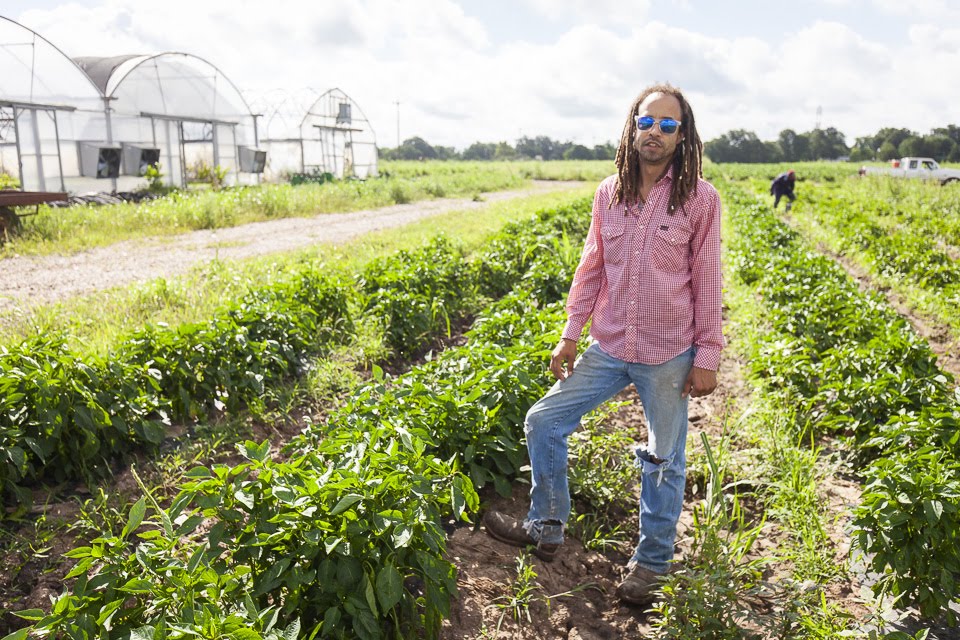 Tracy caught doing some field scouting, looking particularly cool if we do say so.. Photo by Scott David Gordon.
Tracy caught doing some field scouting, looking particularly cool if we do say so.. Photo by Scott David Gordon.
Over the years, we’ve gotten better at succession planting, or the process of spacing out the timing of your plantings so as to extend the crop availability. This year’s green bean crop was a good example. We harvest green beans mechanically, but they are a very labor-intensive crop post-harvest; we have to sort out lots of stems and leaves, and also weigh out and bag the beans. Because we planted the green beans on a more strategic (spaced out) schedule, they were not all ready at once. This means that the quantity of beans harvested was more manageable, and asking our crews to bag the beans was a big (added) task, but not an insurmountable one. Hence, we were able to include more green beans than ever in your CSA shares! Beans tell this tale, too: different crops take different amount of time to harvest and process, so so each week when planning the contents, we also take into consideration the amount of labor we have, how many units of a particular vegetable we need, and try to make sure that we’re not stacking too many labor-intensive vegetables at the same time.
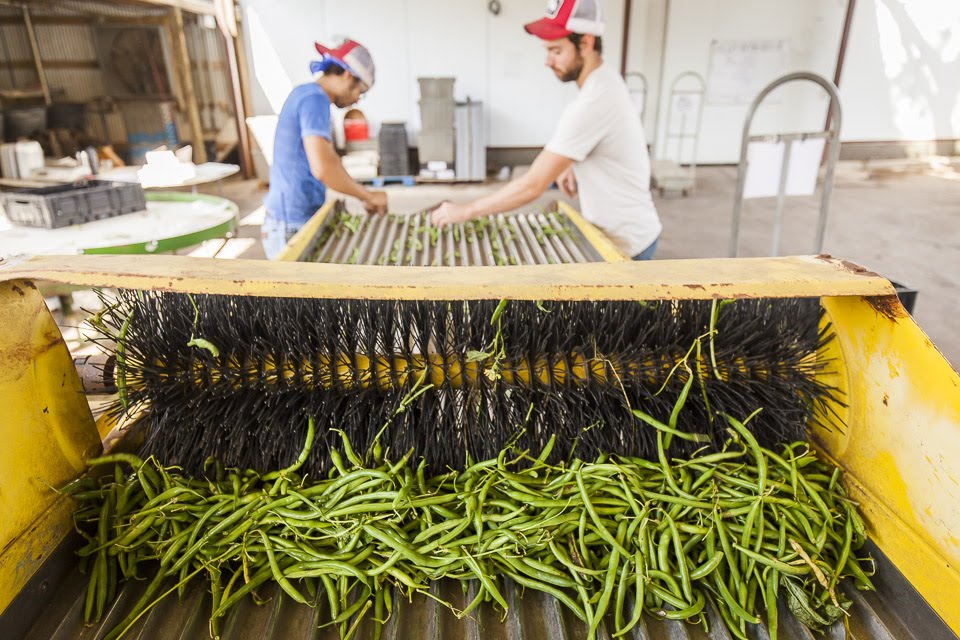 After harvest, green beans get sent through this sorter which we endearingly refer to as the "Mean Green Bean Sorting Machine." Photo of Taylor and Tracy from the archives by Scott David Gordon.
After harvest, green beans get sent through this sorter which we endearingly refer to as the "Mean Green Bean Sorting Machine." Photo of Taylor and Tracy from the archives by Scott David Gordon.
Our number one goal in choosing the box contents is to create a CSA box that you’ll enjoy. Each week, we try to ensure that boxes consist of at least 50-60% of vegetables that we consider staples - carrots, dark leafy greens, potatoes (coming soon: tomatoes!)… as well as some crops that might be new to you, are considered specialty, or are limited in quantity because they’re the very first of the season. Many of our customers receiving Medium and Large boxes are on every-other week schedules, and so when we decide to include a particularly exciting vegetable (that is maybe limited in availability) we make sure that we can do this for two weeks in a row so every customer gets to experience the excitement, at least once. But of course box contents can’t be too similar from week to week, because many of you get a box every week! This brings up an important point, however: when you choose to eat seasonally and locally, the number of crops that are able to be grown in your region at any particular time are going to be less than the variety that you may be accustomed to seeing in the grocery store; so much of this produce is shipped in from different parts of the world, experiencing different growing seasons!. If you’re new to the CSA, you may find yourself opening your box from time to time sighing “Squash, again?”. But stick with the CSA long enough, and not only will you learn 50 wildly different ways to eat squash, but you’ll also recognize the temporal nature of it all. Enjoy the squash bounty (heck, maybe pickle some!) while it lasts, because soon it will be December and you’ll forget what the tender yellow gourds even look like.
Why do the box contents sometimes differ from the contents I was expecting? Whewf! This is a big question. Why did a troop of grasshoppers descend overnight to block A4 of kale? Why did the week of sunshine that we were expecting to size up our squash suddenly shift to a week of clouds? We sometimes have to substitute items in your box due to a catalog of unforeseeable variables which affect either 1)the anticipated quantity of a certain crop or 2)the anticipated quality of a certain crop. Perhaps we had planned to include tender and delicate chard in the boxes because the daily temperatures were looking to be moderate. If the temps spike, we may make a last minute decision to switch this green to kale which can stand up to higher post-harvest temps. We finalize every week’s box contents on the Friday of the week prior, and make sure to enter the quantities we need harvested into our spreadsheet so that this information is waiting for our harvest manager when he gets to work at 5am on Monday. Perhaps a weekend of heavy rain damaged crops on Sunday that looked perfect on Friday. Sometimes, substitutions happen because of mechanical woes: the potato harvester suddenly lost a bolt, and the replacement for said-bolt only exists at one scrap yard (that happens to have the same year and make of our potato harvester) on the West Coast. Even two-day air shipping means that Tuesday boxes may miss out on planned potatoes. Weather, pests, labor, equipment…there are many moments, every day, when we’re called to shift and adapt our plans. That’s farming. More often than not, we’re able to adapt and still make the potatoes happen. But sometimes, we’ve got to send carrots, instead.
When we have no choice but to make a substitution, we always try to sub a like for a like. A bunched green for a bunched green, an herb for an herb, a carrot for a potato (they’re both starchy, root crops, and can be used very similarly!). We hope you learn to roll with the punches when there is dill instead of the expected parsley. Part of being a CSA Member is getting to know your seasons, and there is no more authentic way to know your seasons than to know and understand the variability that even a day can hold. We know you like to plan your meals ahead of time (meal planning is the best!) and we invite you to employ the same flexibility that we practice as farmers as cooks in the kitchen. It’s part of the fun of being a CSA Member, we think! Cooking, like farming, isn’t rigid and subbing parsley for dill will likely taste just fine!
Why does the value of my box sometimes seem to be less than what I’m paying for? Why can I find organic produce that is sometimes cheaper in the grocery store? The CSA boxes are valued at the overall average value, so the exact value may vary box-to-box. There are times in the year (ex: summer) when we have abundant, varied crops, and can give our members more than the box's dollar amount. We also include items like cabbage and cauliflower by count rather than weight, which gives you a better deal. Occasionally, there will be a week when your box may contain one less item than your used to, but we promise that the bonus veggies that come your way throughout a season more than make up for this deficit. For this reason, our CSA program truly is the most economical way to purchase our produce. The cost of food production is often undervalued and also hidden. Occasionally, you may be able to find cheaper versions of organic produce at the grocery store which is produced by highly mechanized farms. Here, the hidden costs lie in the poor working conditions of employees and poor management of farmland and soil health.
Who is the CSA Crew? Really, it’s a whole-farm effort to grow the vegetables for your CSA box. Krishna, Brenton, Andrew, Tracy and Jack all spend weeks crop planning for upcoming seasons. Our greenhouse manager Giana cares for the plant babies that will eventually produce your vegetables. A harvest team of 15-20 folks harvest the vegetables, mostly by hand. There is the barn crew that all pitches in to wash and sort the vegetables, and then there is the CSA team that folds, labels, packs, and checks each and every CSA box. This crew consists of our fearless CSA Packing Manager, Andrew, plus Alexander, Nick, and Brisa. Faith orchestrates the deliveries (and answers your queries), Krishna is making sure we all get paid (among one billion other tasks), and our delivery drivers spend anywhere from 8-10 hours a day bringing you the produce.
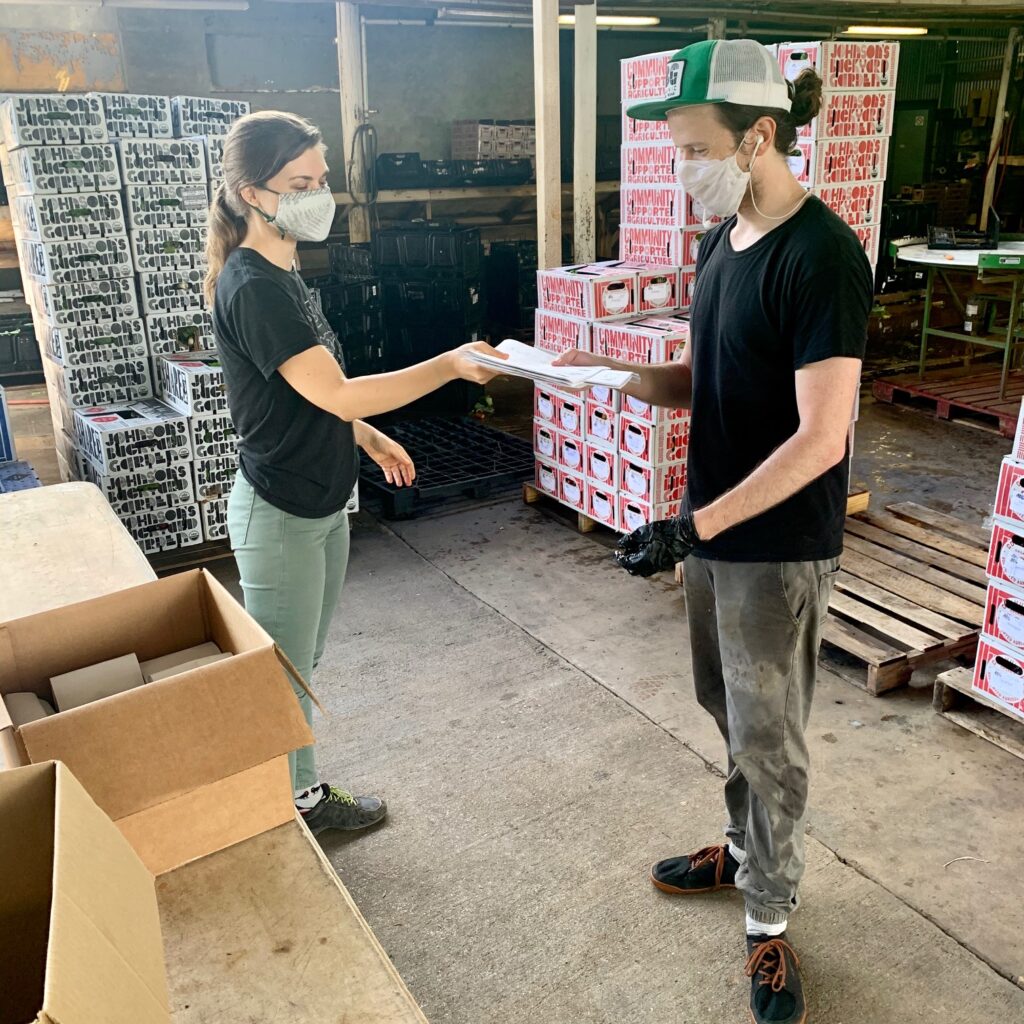 Formatting, organizing, and checking our CSA labels is one of the first things Faith does every morning. There's no worse feeling than when the CSA crew is waiting on their labels! Here is Faith handing the labels off to Alexander. Ready, set, pack! Photo by Scott David Gordon.
Formatting, organizing, and checking our CSA labels is one of the first things Faith does every morning. There's no worse feeling than when the CSA crew is waiting on their labels! Here is Faith handing the labels off to Alexander. Ready, set, pack! Photo by Scott David Gordon.
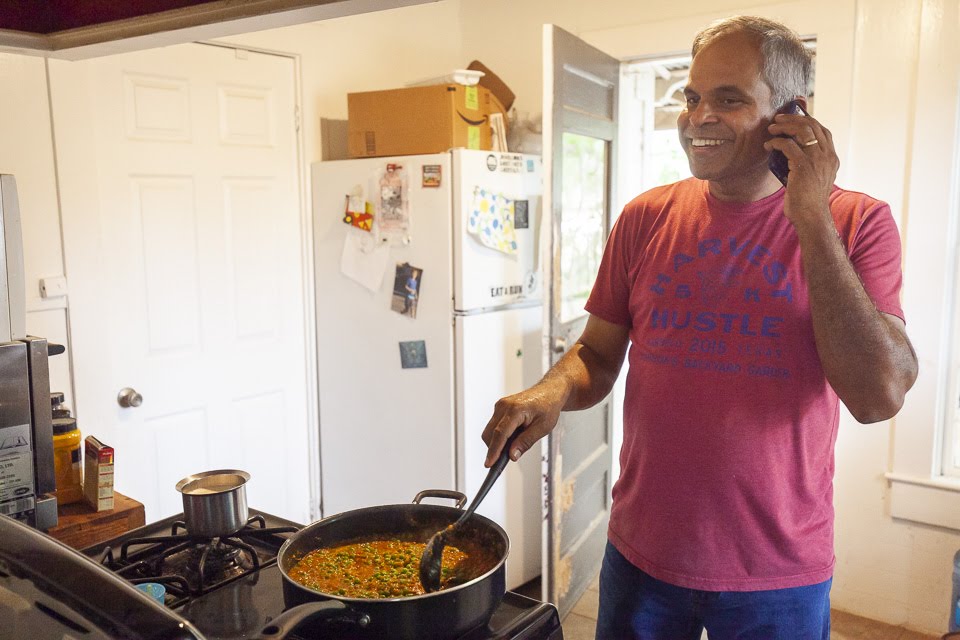 Did we mention Krishna is our number-one multi tasker? Here's a photo from the archives where he's cooking lunch for the barn crew and coordinating van repairs... all at once. Photo by Scott David Gordon.
Did we mention Krishna is our number-one multi tasker? Here's a photo from the archives where he's cooking lunch for the barn crew and coordinating van repairs... all at once. Photo by Scott David Gordon.
What is the best way to store my veggies? Okay, this blog post is getting long! If you’re curious about veggie storage, checkout the blog post we devoted specifically to this topic.
What is the best way to eat my veggies? With your mouth! But really, we have a wonderful recipe archive on our website. The recipes listed here were written and developed by CSA Members like you and if you’re stumped, this is a great resource.
If you made it to the bottom of this post, thank you for reading. We hope this post helps you better understand some of the behind the scenes work that goes into making our CSA Program. If you have any questions, please don't hesitate to ask! Comment below or shoot us an email. As always, thank you for supporting local agriculture. We are so grateful for all of you who make up our vibrant and hungry community!
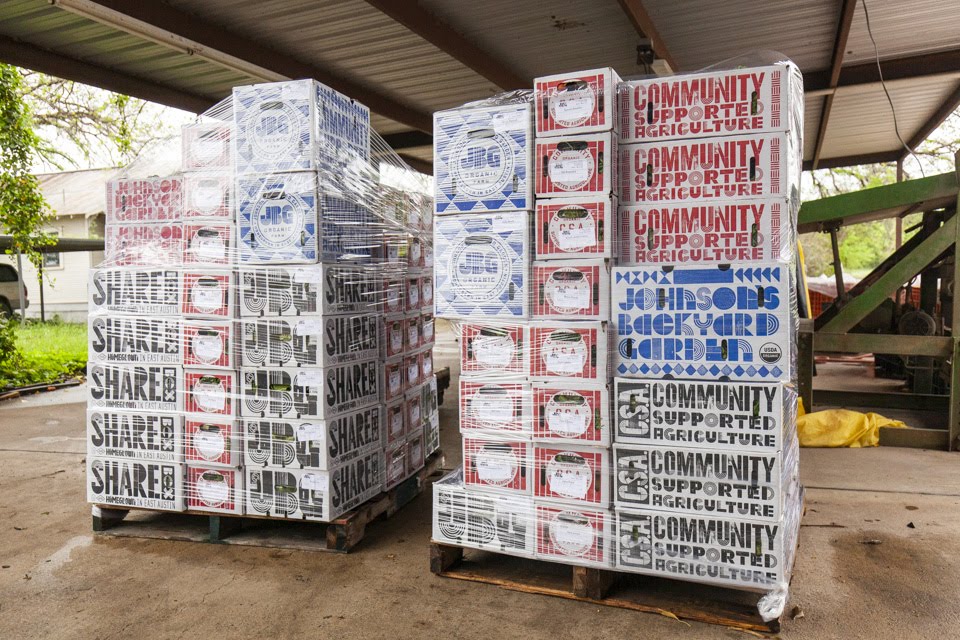






 0 ITEMS IN CART
0 ITEMS IN CART 

